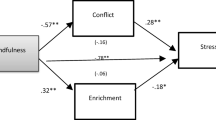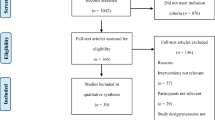Abstract
The present study was designed to examine mindfulness and stress levels in beginner and advanced practitioners of Hatha Yoga. Participants (N = 52) were recruited through Hatha Yoga schools local to western Massachusetts. Beginner practitioners (n = 24) were designated as those with under 5 years (M = 3.33) experience and advanced practitioners (n = 28) as those with over 5 years (M = 14.53) experience in Hatha Yoga. The participants completed the Mindful Attention Awareness Scale (MAAS; Brown and Ryan 2003) and the Perceived Stress Scale (PSS; Cohen et al. 1983) directly preceding a regularly scheduled Hatha Yoga class. Based on two independent-samples t-tests, advanced participants scored significantly higher in mindfulness levels (P < .05) and significantly lower in stress levels (P < .05) when compared to beginner participants. Additionally, a significant negative correlation (r = −.45, P = .00) was found between mindfulness and stress levels. No significant correlations were found between experience levels and mindfulness and stress levels. Hatha Yoga may be an effective technique for enhancing mindfulness and decreasing stress levels in practitioners.
Similar content being viewed by others
References
Arambula, P., Peper, E., Kawakami, M., & Gibney, K. (2001). The physiological correlates of Kundalini yoga meditation: A study of a yoga master. Applied Psychophysiology and Biofeedback, 26(2), 147–153.
Baer, R. (2003). Mindfulness training as a clinical intervention: A conceptual and empirical review. Clinical Psychology: Science and Practice, 10(2), 125–143.
Broderick, P. (2005). Mindfulness and coping with dysphoric mood: Contrasts with rumination and distraction. Cognitive Therapy and Research, 29(5), 501–510.
Brown, K., & Ryan, R. (2003). The benefits of being present: Mindfulness and its role in psychological well-being. Journal of Personality and Social Psychology, 84(4), 822–848.
Carlson, L., & Brown, K. (2005). Validation of the mindful attention awareness scale in a cancer population. Journal of Psychosomatic Research, 58(1), 29–33.
Carmody, J., & Baer, R. (2008). Relationships between mindfulness practice and levels of mindfulness, medical and psychological symptoms and well-being in a mindfulness-based stress reduction program. Journal of Behavioral Medicine, 31, 23–33.
Cohen, S., Kamarck, T., & Mermelstein, R. (1983). A global measure of perceived stress. Journal of Health and Social Behavior, 24, 385–396.
Cohen, S., & Williamson, G. (1988). Perceived stress in a probability sample of the United States. In S. Spacapan & S. Oskamp (Eds.), The social psychology of health: Claremont symposium on applied social psychology (pp. 31–67). Newbury Park, CA: Sage.
Easterlin, B., & Cardena, E. (1998). Cognitive and emotional differences between short- and long-term Vipassana meditators. Imagination, Cognition and Personality, 18(1), 69–81.
Galantino, M., Baime, M., Maguire, M., Szapary, P., & Farrar, J. (2005). Short communication: Association of psychological and physiological measures of stress in health-care professionals during an 8-week mindfulness meditation program: Mindfulness in practice. Stress and Health, 21, 255–261.
Goleman, D., & Schwartz, G. (1976). Meditation as an intervention in stress reactivity. Journal of Consulting and Clinical Psychology, 44(3), 456–466.
Hewitt, J. (1977). The complete yoga book: Yoga of breathing, yoga of posture, yoga of meditation. New York: Schocken.
Iyengar, B. (2001). Yoga: The path to holistic health. London: Dorling Kindersley.
Jain, S., Shapiro, S., Swanick, S., Roesch, S., Mills, P., Bell, I., et al. (2007). A randomized controlled trial of mindfulness meditation versus relaxation training: Effects on distress, positive states of mind, rumination, and distraction. Annals of Behavioral Medicine, 30(1), 11–21.
Kabat-Zinn, J. (1982). An outpatient program in behavioral medicine for chronic pain patients based on the practice of mindfulness meditation: Theoretical considerations and preliminary results. General Hospital Psychiatry, 4, 33–47.
Kabat-Zinn, J. (2005). Coming to our senses: Healing ourselves and the world through mindfulness. New York: Hyperion.
Kabat-Zinn, J., Massion, M., Kristeller, J., Peterson, L., Fletcher, K., Pbert, L., et al. (1992). Effectiveness of a meditation-based stress reduction program in the treatment of anxiety disorders. American Journal of Psychiatry, 149, 936–943.
Langer, E. (1989). Mindfulness. Cambridge, MA: Da Capo.
Lavey, R., Sherman, T., Mueser, K., Osborne, D., Currier, M., & Wolfe, R. (2005). The effects of yoga on mood in psychiatric inpatients. Psychiatric Rehabilitation Journal, 28(4), 399–402.
Mackillop, J., & Anderson, E. (2007). Further psychometric validation of the mindful attention awareness scale (MAAS). Journal of Psychopathology and Behavioral Assessment, 29, 289–293.
Maezumi, T., & Glassman, B. (2002). On Zen practice: Body, breath & mind. Boston: Wisdom.
McEwen, B., & Lasley, E. (2002). The end of stress as we know it. Washington, DC: Joseph Henry.
Metzner, R. (1998). The unfolding self: Varieties of transformative experience. Novato, CA: Origin.
Murata, T., Takahashi, T., Hamada, T., Omori, M., Kosaka, H., Yoshida, H., et al. (2004). Individual trait anxiety levels characterizing the properties of Zen meditation. Neuropsychobiology, 50, 189–194.
Oman, D., Hedberg, J., & Thoresen, C. (2006). Passage meditation reduces perceived stress in health professionals: A randomized, controlled trial. Journal of Consulting and Clinical Psychology, 74(4), 714–719.
Rama, S., Ballentine, R., & Ajaya, S. (1976). Yoga and psychotherapy: The evolution of consciousness. Honesdale, PA: Himalayan Institute.
Ramel, W., Goldin, P., Carmona, P., & McQuaid, J. (2004). The effects of mindfulness meditation on cognitive processes and affect in patients with past depression. Cognitive Therapy and Research, 28(4), 433–455.
Selye, H. (1976). The stress of life. New York: McGraw-Hill.
Shapiro, S., Brown, K., & Biegel, G. (2007). Teaching self-care to caregivers: Effects of mindfulness-based stress reduction on the mental health of therapists in training. Training and Education in Professional Psychology, 1(2), 105–115.
Shapiro, S., Oman, D., Thoresen, C., Plante, T., & Flinders, T. (2008). Cultivating mindfulness: Effects on well-being. Journal of Clinical Psychology, 64(7), 840–862.
Shapiro, S., Schwartz, G., & Bonner, G. (1998). Effects of mindfulness-based stress reduction on medical and premedical students. Journal of Behavioral Medicine, 21(6), 581–599.
Tart, C. (1975). States of consciousness. New York: E.P. Dutton.
Tart, C. (1994). Living the mindful life: A handbook for living in the present moment. Boston: Shambhala Publications.
Teasdale, J., Williams, J., Soulsby, J., Segal, Z., Ridgeway, V., & Lau, M. (2000). Prevention of relapse/recurrence in major depression by mindfulness-based cognitive therapy. Journal of Consulting and Clinical Psychology, 68, 615–623.
Telles, S., Joshi, M., Dash, M., Raghuraj, P., Naveen, K., & Nagendra, H. (2004). An evaluation of the ability to voluntarily reduce the heart rate after a month of yoga practice. Integrative Physiological and Behavioral Science, 39(2), 119–125.
Telles, S., Reddy, S., & Nagendra, H. (2000). Oxygen consumption and respiration following two yoga relaxation techniques. Applied Psychophysiology and Biofeedback, 25(4), 221–227.
Valente, V., & Marotta, A. (2005). The impact of Yoga on the professional and personal life of the psychotherapist. Contempory Family Therapy, 27(1), 65–80.
Valentine, E., & Sweet, P. (1999). Meditation and attention: A comparison of the effects of concentrative and mindfulness meditation on sustained attention. Mental Health, Religion & Culture, 2(1), 59–70.
Walton, K., Schneider, R., Nidich, S., Salerno, J., Nordstrom, C., & Merz, N. (2002). Psychosocial stress and cardiovascular disease part 2: Effectiveness of the transcendental meditation program in treatment and prevention. Behavioral Medicine, 28, 106–123.
Wilber, K. (1977). The spectrum of consciousness (2nd ed.). Wheaton, IL: The Theosophical Publishing House.
Wilber, K. (1999). The collected works of Ken Wilber (Vol. 4, pp. 363–364). Boston: Shambhala.
Author information
Authors and Affiliations
Corresponding author
Rights and permissions
About this article
Cite this article
Brisbon, N.M., Lowery, G.A. Mindfulness and Levels of Stress: A Comparison of Beginner and Advanced Hatha Yoga Practitioners. J Relig Health 50, 931–941 (2011). https://doi.org/10.1007/s10943-009-9305-3
Published:
Issue Date:
DOI: https://doi.org/10.1007/s10943-009-9305-3




